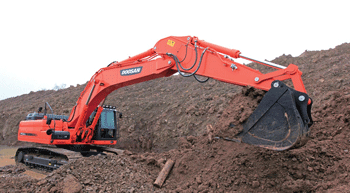
CE Sector to Grow
Among the major global markets for construction equipment, the demand of construction equipment in China suffered a steep decline after peaking in 2011. This trend continued in 2014; however, future demand forecast is expected to be stable. The construction equipment demand in India has also witnessed a steady decline after 2011, but future outlook is positive.
North America and Japan have witnessed a steady growth since 2009. This trend is expected to continue in North America until 2017, while the Japanese market sentiment is weak and the demand is expected to witness a continuous decline until 2018. During this period, the European market has fluctuated, but is expected to remain stable until 2018.
The new government assumed office in May 2014, but despite high expectations, things have not moved quickly because of the huge backlog and unfinished work. Although the prevailing industry sentiment is positive, the construction equipment market is now expected to decline in 2014, as the activity level is yet to gather pace. Current construction equipment scenario looks optimistic mainly on account of improved business sentiment after the change in government in May 2014. However, the quarterly numbers still do not point towards substantial improvement. There is no doubt that the government has taken several administrative measures to speed up infrastructure development, but the result will only be visible in 2015.
In addition to the ongoing projects, the government has announced many new projects such as the development of 100 smart cities and industrial corridors, high-speed rail network, linking of rivers and development of waterways. It is also focusing on the completion of all pending railway projects, and its modernization and promotion of private sector participation for infrastructure development.
One of the reasons for the low interest of private sector in road construction projects is that contracts for the segments that have larger potential to generate revenues have already been awarded and current stretches on offer are not as lucrative. Further, the vehicle traffic had also reduced with economic downturn, which is causing financial stress on many projects.
Secondly, many construction companies are facing liquidity constraints, and as a result the finance has become a major bottleneck for all infrastructure projects including the road sector. The prevailing high interest rates are adding to this problem but there are indications that with recent fall in inflation, interest rates may be revised downwards in the near future. This should help the infrastructure sector and boost construction equipment sales.
The initiatives taken by the government to revive the road sector in the country include larger financial allocations and a better policy framework for the execution of projects. It is clearing all hurdles that had stalled the road projects in the recent past, such as problems related to land acquisition, environmental clearances (especially in the border Himalayan region), local political problems and other administrative measures. It is also modifying the Model Concession Agreement (MCA) to attract private investment and is currently awarding EPC contracts to build momentum in the road construction sector.
Mining sector has underperformed in the country during the past five years, despite a massive growth potential on account of social, political and legal issues coupled with problems related to land acquisition and rehabilitation, and government clearances and approvals. However, some positive movement is now visible in this sector as the new government is trying to tackle the constraining issues as mining growth will also support infrastructure development.
Problems related to the coal sector are being addressed on priority basis by the government as it is the major source of power in the country and ?Make in India? policy also needs a stable power infrastructure. Despite huge reserves of coal, the domestic production is not able to meet the demand leading to increased imports and higher current account deficit. The coal production is likely to increase substantially in 2015.
The demand for steel and cement in the country is already growing with improved business sentiment and are much needed for infrastructure development. Further, most of the legal issues related to iron ore mining have now been resolved. Therefore, increased activity levels are expected in limestone as well as iron ore segments, which would lead to improved sales of mining equipment.
The new government has laid down a broad policy for taking the country?s economic growth to 7-8 per cent within the next 3-4 years. It wants to revive growth in the manufacturing and infrastructure sectors, while reducing the fiscal deficit by improving the tax-to-GDP ratio and increasing non-tax revenues. However, these are bound to take some time and there will be a lag before the actual results start showing on the ground.
Streamlining of policies and procedures are the major initiatives being taken by the new government for faster execution of infrastructure projects that have the potential to increase the demand of construction equipment in the country.
The government has moved fast in allocation of coal mines after the Supreme Court cancelled the allocations made by the previous government. It is inviting foreign and domestic investments in infrastructure sector and is trying to tap pension and insurance funds for long-term financing by creating infrastructure debt funds (IDFs). Award of EPC contracts for road projects has started and a number of new projects in various sectors have been announced to build construction activity momentum. After a decline of 15 per cent in 2013, the market for construction equipment in India is expected to decline by a further 16 per cent in 2014, but the situation is likely to improve from the first quarter of 2015 as the government?s initiatives start bearing results and construction activity picks up. Off-Highway Research is bullish about the market recovery in 2015 and the industry is estimated to grow in the long term to reach a level of 89,000 units by 2018 at a CAGR of 17.5 per cent over 2014.
The author is General Manager - India,
Off-Highway Research.


 +91-22-24193000
+91-22-24193000 Subscriber@ASAPPinfoGlobal.com
Subscriber@ASAPPinfoGlobal.com